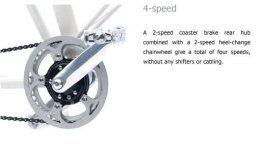What do you guys think the best wheel size for the "driven wheel" is? I'd guess a smaller wheel!
The reasoning being is that a gear ratio at 26" would be equivalent to half that gear ratio on a 13" wheel. In real life, the next practical size is 16" but you get the idea: You can substantially reduce your gear ratio by designing with a small wheel in mind. This can mean the difference between a one stage and two stage drive which then means cheaper, increased drive efficiency and, most importantly, more POWER!
I wondered why bicycles have 26" wheels to begin with, though. I thought maybe it was to help handle pot holes or something like that, so I went to a motorcycle wheel seller and it seemed 18" was the most common size! I think motorcycles have to worry more about potholes than bicycles but yet there common size seems a tad fair bit smaller suggesting that a smaller wheel won't hurt.
Ok, an example... let's say a gear ratio of 12.0 seemed about right on a 135 kV motor on a 26" wheel. On equivalent gear ratio on 16" is about 7 which seems to be well within the single drive system.
I have questions about how the brakes would be put on the bike, though. Some gearing setups interfere with disc brakes but it seems calipers wouldn't be ideal on a 16" wheel on a 26" mountain bike, so it seems back brakes would be eliminated on mountain bikes unless one has a clever circumvention or uses a right side drive which seems to introduce other complications.
The reasoning being is that a gear ratio at 26" would be equivalent to half that gear ratio on a 13" wheel. In real life, the next practical size is 16" but you get the idea: You can substantially reduce your gear ratio by designing with a small wheel in mind. This can mean the difference between a one stage and two stage drive which then means cheaper, increased drive efficiency and, most importantly, more POWER!
I wondered why bicycles have 26" wheels to begin with, though. I thought maybe it was to help handle pot holes or something like that, so I went to a motorcycle wheel seller and it seemed 18" was the most common size! I think motorcycles have to worry more about potholes than bicycles but yet there common size seems a tad fair bit smaller suggesting that a smaller wheel won't hurt.
Ok, an example... let's say a gear ratio of 12.0 seemed about right on a 135 kV motor on a 26" wheel. On equivalent gear ratio on 16" is about 7 which seems to be well within the single drive system.
I have questions about how the brakes would be put on the bike, though. Some gearing setups interfere with disc brakes but it seems calipers wouldn't be ideal on a 16" wheel on a 26" mountain bike, so it seems back brakes would be eliminated on mountain bikes unless one has a clever circumvention or uses a right side drive which seems to introduce other complications.



